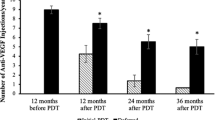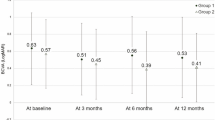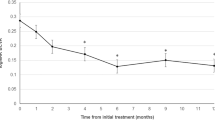Abstract
Purpose
To assess treatment response of Polypoidal choroidal vasculopathy (PCV) in a Caucasian population of British ethnicity with intravitreal anti-vascular endothelial growth factor (anti-VEGF) injections alone and with a combination of anti-VEGF injections and photodynamic therapy (PDT).
Setting/venue
Department of Ophthalmology, University Hospital Southampton NHS Foundation Trust, United Kingdom.
Methods
Retrospective review of 95 Caucasian patients in a single centre with diagnosis of PCV between 2013 and 2018 were included. Best corrected visual acuity (BCVA), central retinal thickness (CRT), indocyanine green angiography (ICGA) characteristics, numbers and type of treatment were analysed at baseline and at 1 year.
Results
One hundred and one eyes included from 95 patients received either anti-VEGF injections (n = 79, 78.2%) alone or combination therapy with anti-VEGF and PDT (n = 6, 6%). A third untreated group was also observed (n = 16, 15.8%). Five eyes were excluded from the study due to structural retinal damage. Mean number of injections was 7.3 in the monotherapy group and 6.5 in the combination group. Both treatment groups showed improvement in BCVA at 1 year and this was statistically significant in the monotherapy group with a mean gain of 8.3 letters (p < 0.001). Mean CRT decreased in all treatment groups at twelve months and this change was significant (p < 0.01). In the observation group, vision and CRT remained stable.
Conclusions
This study demonstrates significant improvements in BCVA at one year in our Caucasian cohort of British ethnicity with PCV in the treatment group.
This is a preview of subscription content, access via your institution
Access options
Subscribe to this journal
Receive 18 print issues and online access
$259.00 per year
only $14.39 per issue
Buy this article
- Purchase on SpringerLink
- Instant access to full article PDF
Prices may be subject to local taxes which are calculated during checkout



Similar content being viewed by others
Data availability
The data that support the findings of this study are not openly available due to the sensitive nature, are all anonymised and available upon reasonable request at the University Hospital Southampton NHS Foundation Trust as per the applicable Trust data protection policy.
References
Yannuzzi LA, Sorenson J, Spaide RF, Lipson B. Idiopathic polypoidal choroidal vasculopathy (IPCV). Retina. 1990;10:1–8.
Spaide RF, Jaffe GJ, Sarraf D, Freund KB, Sadda SR, Staurenghi G, et al. Consensus nomenclature for reporting neovascular age-related macular degeneration data: consensus on neovascular age-related macular degeneration nomenclature study group. Ophthalmology. 2020;127:616–36.
Laude A, Cackett PD, Vithana EN, Yeo IY, Wong D, Koh AH, et al. Polypoidal choroidal vasculopathy and neovascular age-related macular degeneration: same or different disease? Prog Retin Eye Res 2010;29:19–29.
Lee MW, Yeo I, Wong D, Ang CL. Argon laser photocoagulation for the treatment of polypoidal choroidal vasculopathy. Eye. 2009;23:145–8.
Koh A, Lee WK, Chen LJ, Chen SJ, Hashad Y, Kim H, et al. EVEREST study: efficacy and safety of verteporfin photodynamic therapy in combination with ranibizumab or alone versus ranibizumab monotherapy in patients with symptomatic macular polypoidal choroidal vasculopathy. Retina. 2012;32:1453–64.
Tan CS, Ngo WK, Chen JP, Tan NW, Lim TH, EVEREST Study G. EVEREST study report 2: imaging and grading protocol, and baseline characteristics of a randomised controlled trial of polypoidal choroidal vasculopathy. Br J Ophthalmol. 2015;99:624–8.
Japanese Study Group of Polypoidal Choroidal Vasculopathy. Criteria for diagnosis of polypoidal choroidal vasculopathy. Nippon Ganka Gakkai Zasshi. 2005;109:417–27.
De Salvo G, Vaz-Pereira S, Keane PA, Tufail A, Liew G. Sensitivity and specificity of spectral-domain optical coherence tomography in detecting idiopathic polypoidal choroidal vasculopathy. Am J Ophthalmol. 2014;158:1228–38.e1.
Cheung C, Lai T, Teo K, Ruamviboonsuk P, Chen SJ, Kim JE, et al. Polypoidal choroidal vasculopathy: consensus nomenclature and non-indocyanine green angiograph diagnostic criteria from the Asia-Pacific Ocular Imaging Society PCV workgroup. Ophthalmology. 2021;128:443–52.
Ranibizumab and pegaptanib for the treatment of age-related macular degeneration. Technology appraisal guidance [TA155]. 2008. https://www.nice.org.uk/guidance/ta155
Aflibercept solution for injection for treating wet age related macular degeneration. Technology appraisal guidance [TA294]. 2013. https://www.nice.org.uk/guidance/ta294
Age-related macular degeneration. NICE guideline [NG82]. 2018. https://www.nice.org.uk/guidance/ng82
Corvi F, Chandra S, Invernizzi A, Pace L, Viola F, Sivaprasad S, et al. Multimodal imaging comparison of polypoidal choroidal vasculopathy between asian and caucasian populations. Am J Ophthalmol. 2022;234:108–16.
Yadav S, Parry DG, Beare NAV, Pearce IA. Polypoidal choroidal vasculopathy: a common type of neovascular age-related macular degeneration in Caucasians. Br J Ophthalmol. 2017;101:1377–80.
Balaratnasingam C, Lee WK, Koizumi H, Dansingani K, Inoue M, Freund KB. Polypoidal choroidal vasculopathy: a distinct disease or manifestation of many? Retina. 2016;36:1–8.
Agorogiannis EI, Pearce IA, Yadav S, Parry DG, Beare N. Clinical outcomes in Caucasian patients with polypoidal choroidal vasculopathy. Eye. 2018;32:1731–9.
Wolff B, Vasseur V, Cahuzac A, Coscas F, Castelnovo L, Favard C, et al. Aflibercept treatment in polypoidal choroidal vasculopathy: results of a prospective study in a Caucasian population. Ophthalmologica. 2018;240:208–12.
Hatz K, Prünte C. Polypoidal choroidal vasculopathy in Caucasian patients with presumed neovascular age-related macular degeneration and poor ranibizumab response. Br J Ophthalmol. 2014;98:188–94.
Lafaut BA, Leys AM, Snyers B. Polypoidal choroidal vasculopathy in Caucasians. Graefes Arch Clin Exp Ophthalmol. 2000;238:752–9.
Lee WK, Iida T, Ogura Y, Chen SJ, Wong TY, Mitchell P, et al. Efficacy and safety of intravitreal aflibercept for polypoidal choroidal vasculopathy in the PLANET Study: A Randomised clinical trial. JAMA Ophthalmol. 2018;36:786–93.
Wong CW, Yanagi Y, Lee WK, Ogura Y, Yeo I, Wong TY, et al. Age-related macular degeneration and polypoidal choroidal vasculopathy in Asians. Prog Retin Eye Res. 2016;53:107–39.
Nowak-Sliwinska P, van den Bergh H, Sickenberg M. Photodynamic therapy for polypoidal choroidal vasculopathy. Prog Retin Eye Res. 2013;37:182–99.
Wakabayashi T, Gomi F, Sawa M, Tsujikawa M, Tano Y. Marked vascular changes of polypoidal choroidal vasculopathy after photodynamic therapy. Br J Ophthalmol. 2008;92:936–40.
Wong CW, Cheung CM, Mathur R, Li X, Chan CM, Yeo I, et al. Three-year results of polypoidal choroidal vasculopathy treated with photodynamic therapy: Retrospective Study and Systematic Review. Retina. 2015;35:1577–93.
Klais CM, Ober MD, Freund KB, Ginsburg LH, Luckie A, Mauget-Faÿsse M, et al. Choroidal infarction following photodynamic therapy with verteporfin. Arch Ophthalmol. 2005;123:1149–53.
Kim SW, Oh J, Oh IK, Huh K. Retinal pigment epithelial tear after half fluence PDT for serous pigment epithelial detachment in central serous chorioretinopathy. Ophthalmic Surg Lasers Imaging. 2009;40:300–3.
Jeon S, Lee WK, Kim KS. Adjusted retreatment of polypoidal choroidal vasculopathy after combination therapy: results at 3 years. Retina. 2013;33:1193–200.
Yamashita A, Shiraga F, Shiragami C, Shirakata Y, Fujiwara A. Two-year results of reduced-fluence photodynamic therapy for polypoidal choroidal vasculopathy. Am J Ophthalmol. 2013;155:96–102.e1.
Kokame GT, Yeung L, Teramoto K, Lai JC, Wee R. Polypoidal choroidal vasculopathy exudation and hemorrhage: results of monthly ranibizumab therapy at one year. Ophthalmologica. 2014;231:94–102.
Ogura Y, Terasaki H, Gomi F, Yuzawa M, Iida T, Honda M, et al. Efficacy and safety of intravitreal aflibercept injection in wet age-related macular degeneration: outcomes in the Japanese subgroup of the VIEW 2 study. Br J Ophthalmol. 2015;99:92–7.
Oishi A, Miyamoto N, Mandai M, Honda S, Matsuoka T, Oh H, et al. LAPTOP study: a 24-month trial of verteporfin versus ranibizumab for polypoidal choroidal vasculopathy. Ophthalmology. 2014;121:1151–2.
Cheung CMG. Macular neovascularization and polypoidal choroidal vasculopathy: phenotypic variations, pathogenic mechanisms and implications in management. Eye (Lond). 2023;38:659–67. https://doi.org/10.1038/s41433-023-02764-w.
Kokame GT, Tom ES, Shantha JG, Kaneko KN. Polypoidal choroidal vasculopathy in highly myopic eyes with elongated axial length. Open Ophthalmol J. 2017;11:326–33.
Cheung CMG, Lee WK, Koizumi H, Dansingani K, Lai TYY, Freund KB. Pachychoroid disease. Eye (Lond). 2019;33:14–33.
Siedlecki J, Klaas JE, Keidel LF, Asani B, Luft N, Priglinger SG, et al. Progression of pachychoroid neovasculopathy into aneurysmal type 1 choroidal neovascularization or polypoidal choroidal vasculopathy. Ophthalmol Retin. 2022;6:807–13.
Author information
Authors and Affiliations
Contributions
GDS developed the concept of the study, contributed to writing the article and did supervision of the project. ST contributed the writing of the article, data collection, interpretation and analysis. RB, AP, NA collaborated in initial data collection and contribution to the first draft. RF contributed to writing the article and also supervised the project.
Corresponding author
Ethics declarations
Competing interests
GDS – is Advisory Board member to Novartis, Bayer, Teva, Allergan and Apellis. She has received Travel grants from Heidelberg Engineering, Novartis, Bayer, Roche, Allergan and also received educational grant from Bayer. She has also done Consultancy work to Boehringer Ingelheim. Dr De Salvo also serves as the section editor to the Eye Journal. RF – is a member of the editorial board to the Eye Journal. The remaining authors decalre no competing interests.
Additional information
Publisher’s note Springer Nature remains neutral with regard to jurisdictional claims in published maps and institutional affiliations.
Rights and permissions
Springer Nature or its licensor (e.g. a society or other partner) holds exclusive rights to this article under a publishing agreement with the author(s) or other rightsholder(s); author self-archiving of the accepted manuscript version of this article is solely governed by the terms of such publishing agreement and applicable law.
About this article
Cite this article
De Salvo, G., Thulasidharan, S., Barbara, R. et al. Real world treatment outcomes in polypoidal choroidal vasculopathy in a Caucasian population of British ethnicity. Eye (2024). https://doi.org/10.1038/s41433-024-03221-y
Received:
Revised:
Accepted:
Published:
DOI: https://doi.org/10.1038/s41433-024-03221-y



